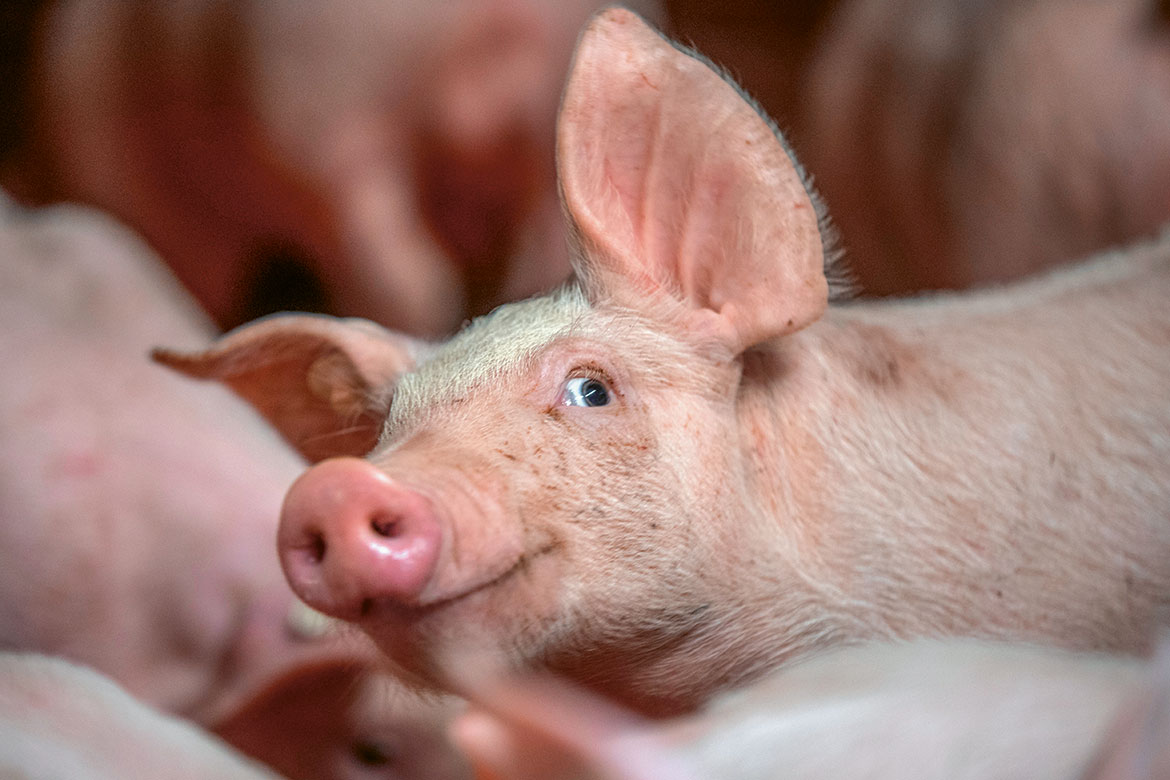Animal feelings
Research into emotions will supposedly help us improve livestock farming. But this young discipline is still seeking new, reliable measurement methods.

Researchers are currently developing software to recognise negative emotions in pigs, depending on the sounds they make. It could help to make for happier pigsties. | Picture: Keystone/DPA/Z1003/Jens Büttner
Anticipation, stage fright, disappointment – such emotions determine our lives. But not just ours. Animals, too, are emotional beings. Charles Darwin postulated this already 150 years ago, but it’s only in recent years that scientists have begun to agree with him. “Even after Darwin, researchers still regarded animals as machines for a long time. It was only in the 1990s that they began studying their emotions”, says the animal physiologist Elodie Briefer, who recently left ETH Zurich to go and work at the University of Copenhagen.
Meanwhile, the number of research groups studying animal emotions has grown constantly. Hanno Würbel, a professor of animal welfare at the University of Bern, maintains that “there is hardly anything more interesting than researching into the emotional world of living beings”. But this isn’t the only reason for this surge in research into animals’ feelings. “Distinguishing between positive and negative emotions is also at the heart of animal welfare”, he says. All the same, that’s easier said than done. Every dog owner will know that something is wrong if his pet trembles and whimpers. But it’s difficult for us humans to judge the precise emotional state of an animal.
Is a low pulse a sign of calm, or depression?
We can’t ask animals what they’re feeling, so researchers have recourse to various indicators. One approach is to study neurophysiological reactions to specific stimuli – such as changes in heart frequency or brain activity. “These kinds of study have the advantage of being based on accurate measurements; however, we often have to be careful about how we interpret them”, says Lorenz Gygax, who used to work at the Centre for animal-friendly husbandry in Tänikon in the canton of Thurgau, and today researches at the Humboldt University in Berlin. A doctoral candidate in Tänikon once used the pulse to investigate how goats react when they enter a new group. “Their heart rate decreased, but it wasn’t because they were more relaxed – the goats withdrew completely in their new environment and only lay around. They barely dared to move”.
These changes in behaviour are another means of measuring emotions. Elodie Briefer, for example, is investigating how animals communicate their emotional state to others of their species by means of vocalisations. She has discovered that horses neigh in two voices; each neigh is comprised of two different, independent, basic frequencies. “One frequency signifies whether it’s a positive or a negative emotion; the other signifies how strong this emotion is”, says Briefer. And it’s not just other horses that can tell whether one of them is in a good or a bad mood. The humans that know them can tell this, too.
All in all, our insights into the world of animal emotions remain limited, as another example from Gygax’s research demonstrates. He is looking at ear movements and ear positions as a means of measuring the attentiveness of sheep. “The sheep we have examined pointed their ears forwards and moved them vehemently when we confronted them with a negative stimulus”, says Gygax. French researchers, however, have found that ears pointing backwards are a sign of stress in other breeds of sheep. In these experiments, “negative stimuli” comprised being separated from their group, for example, or being exposed to heat. Gygax says that such behavioural data offers a promising approach, but it’s also problematical. “Depending on the emotion, it’s not just different species that offer varying responses – different breeds of the same species can also respond quite differently”.
What’s more, it can also happen that brief stimuli are insufficient to cause a measurable response in an animal. One doctoral candidate was investigating the belief common among horse owners that they can read the emotional state of a horse from the so-called worry lines above its eyes. “And we indeed found one or two parameters that changed in unpleasant situations”, says Würbel. But these changes were not marked enough for them to be regarded as reliable indicators. Perhaps worry lines also form only as a result of a longer-term, negative mood.
Mood swings
These long-term moods, all the researchers agree, are in any case far more important for the well-being of an animal than any short-term emotions. And this brings us to one of the newest, most promising investigative methods – the search for cognitive indicators. To this end, the researchers first put the animals in a positive or negative basic mood, and afterwards observe how they react to certain stimuli. This method is based on findings made in humans: whoever is depressed will react differently to an event from someone who is happy. One will see a half-empty glass, the other a glass that’s half-full. There are meanwhile indications that sheep, pigs, rats, songbirds and even bees react one way or another depending on their mood, says Würbel. “That offers us a peephole into the emotional lives of animals”. This type of experiment is extremely complicated, however.
The results of this emotional research have not yet found their way into animal protection laws – the field is still too young and too complex. But progress is being made that could soon be of assistance to livestock owners, says Elodie Briefer. She is involved in a European project that is developing software to recognise the negative sounds made by pigs. Their idea is that if these signals of fear or pain exceed a certain threshold value, then the pig farmer will be sent an alarm so that he knows something is wrong with his animals.




